H O T S W A P — Replacement of a failed component while the system is running and operating normally.
I N I T I A L I Z A T I O N — The process of writing zeros to the data fields of a virtual disk and, in fault tolerant RAID levels, generating the corresponding parity to put the virtual disk in a Ready state. Initialization generates parity information, so that the virtual disk is redundant. Virtual disks can work without initialization, but they are not truly redundant until initialization is performed.
INT 13 H — A DOS interrupt used to activate seek, read, write and format disk functions. The Int 13h interface supports physical disks that contain up to an approximate maximum disk space of 8.45 GB.
JBOD (J U S T A B U N C H O F D I S K S [D R I V E S ]) — A storage subsystem that uses a single or multiple, independent disk drives.
LED (L I G H T E M I T T I N G D I O D E ) — An electronic device that illuminates when powered.
L O A D B A L A N C I N G — Load balancing is a method of spreading work between two or more computers, network links, CPUs, physical disk drives, or other resources. Load balancing is used to maximize resource use, throughput, or response time. In the controllers, the balancing service is performed by the firmware. You can choose between a single path for load balancing, and a
MB — Acronym for megabyte(s). The term megabyte means 1,048,576 bytes (2^20 bytes); however, when referring to hard drive storage, the term is often rounded to mean 1,000,000 bytes.
M I R R O R I N G — The process of providing complete redundancy using two physical disks, by maintaining an exact copy of one physical disk’s data on the second physical disk. If one physical disk fails, the contents of the other physical disk can be used to maintain the integrity of the system and to rebuild the failed physical disk.
NAS (N E T W O R K A T T A C H E D S T O R A G E ) — A server that runs an operating system for handling files, and which is accessible directly on a LAN by using protocols like TCP/IP.
106
Glossary
